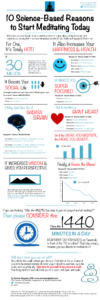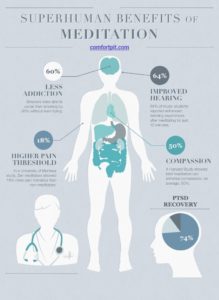In a world where we tend to focus so much more on “doing” vs “being”, where our To-Do list keeps growing, and where we often focus more on the future (ie: goals, better days, finishing projects, etc) rather than being present right here and now, meditation offers us stillness and peace of mind.
What are the benefits of mindfulness?
Mindfulness has roots in Buddhism, but many religions and spiritual practices include some form of meditation technique to help quiet your mind, expand your awareness, and shift your perspective on life toward a greater appreciation of the present moment.
- Mindfulness improves quality of life.
- Being mindful creates a greater capacity to deal with adverse events.
- By focusing on the here and now, you are less likely to worry about the future or regret the past.
Mindfulness Meditation also:
- helps relieve stress and anxiety
- treats heart disease
- lowers blood pressure
- reduces chronic pain
- improves sleep
- relieves symptoms of depression
Mindfulness techniques
The goal of mindfulness meditation is to achieve a state of alert, focused relaxation by deliberately paying attention to thoughts, sensations and surroundings without judgment. This allows the mind to refocus on the present moment.
Basic mindfulness meditation – Sit quietly and focus on your breath or on a word or “mantra” that you repeat silently. Allow thoughts to come and go without judgment and return to your focus on breath or mantra.
Body sensations – Notice subtle body sensations such as an itch or tingling without judgment and let them pass. Notice each part of your body in succession from head to toe.
Sensory – Notice sights, sounds, smells, taste, and touch. Become aware of them, name them without judgment and let them go.
Emotions – Allow emotions to be present without judgment. Practice a relaxed naming of emotions: “joy,” “anger,” “frustration.” Accept the emotions that are present without judgment and then let them go.
Formal Practice:
Start by developing your ability to concentrate, typically by focusing on your breathing., while allowing all of the thoughts that arise to come and go without getting carried away with them.
Here is a basic outline of a formal mindfulness meditation practice.
- Sit on a chair or cross-legged on the floor, with back straight… comfortable but not slouching.
- Focus on an aspect of your breathing, such as the sensations of air flowing into your nostrils and out of your mouth, or your belly rising and falling as you inhale and exhale.
- As you focus your concentration in this way, begin to widen your focus. Become aware of sounds, sensations, and your ideas.
- Embrace and consider each thought or sensation without judging it good or bad. If your mind starts to race, return your focus to your breathing. Then expand your awareness again.
Mindfulness meditation builds upon concentration practices:
- Go with the flow: In mindfulness meditation, after you establish concentration, you observe the flow of your thoughts, emotions, and physical sensations without judging them as good or bad.
- Awareness: You also notice external stimuli such as sounds, sights, and touch in your moment-by-moment experience. The challenge is not to get caught up in your ideas, emotions, or sensations, and to focus on the present rather than thinking about the past or the future. Just watch what comes and goes in your mind and be aware of which mental habits produce a feeling of happiness or suffering.
- Acceptance: mindfulness practice involves accepting whatever arises in your awareness. If your mind wanders into planning, to do lists, daydreaming, or criticism, notice where it has gone and gently redirect it to sensations in the present such as coming back to focusing on your breath.
This practice will also make it easier to accept whatever comes your way during the rest of your day.
Informal Practice:
In addition to formal meditation, a less formal approach to mindfulness can also help you to stay in the present and fully participate in your life by focusing your attention on your moment-to-moment sensations during everyday activities. This is done by focusing fully on any single task or activity in your day such as brushing your teeth, going for a walk, eating a piece of fruit, or showering. Just slow down the process and be fully present as it unfolds and involves all of your senses. These points will help:
- Start by paying attention to the sensations in your body
- Breathe in through your nose and down into your lower abdomen. Let your belly expand fully. Then exhale through your mouth
- Notice the sensations of each inhalation and exhalation
- Now perform the task or activity slowly and with full deliberation
- Engage your senses fully. Notice each sight, touch, sound and feel every sensation.
- When you notice you notice your mind wandering, gently bring your attention back to the sensations of the moment.
Mindfulness exercises
If mindfulness meditation appeals to you, going to a class or listening to a meditation tape can be a good way to start. There are also meditation “retreats” you can participate in to fully immerse yourself in this practice. Here are several free guided meditation audio / mp3 resources you can download at the links below:
http://www.soundstrue.com/store/gifts/freefree
http://mindfulness-solution.com/DownloadMeditations.html
Be Here, Now.




